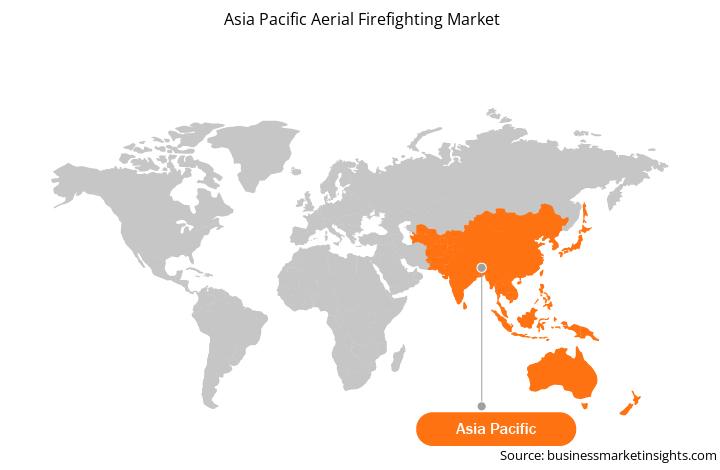The Asia Pacific aerial firefighting market was valued at US$ 110.65 million in 2023 and is expected to reach US$ 205.53 million by 2031; it is estimated to register a CAGR of 8.0% from 2023 to 2031.
With the technological advancements in recent years, the prospects for aerial firefighting hold significant potential. Groundbreaking developments such as drones equipped with thermal imaging cameras and artificial intelligence algorithms have the potential to transform wildfire detection and response completely. Autonomous firefighting aircraft could offer a faster and safer approach to extinguishing fires, while improved fire-retardant delivery systems aim to improve the accuracy and effectiveness of drops. Ongoing research into advanced materials and designs aims to create more efficient and environmentally friendly aerial firefighting solutions.
In addition, there is a rise in investment toward technological advancements, such as detachable or removable water tanks in aerial firefighting fleets. For instance, in July 2022, Airbus SA tested its roll-on/roll-off system to drop water from the removable tank in an Airbus A400M. This removable tank kit can be connected to any aircraft with no modification. Thus, the rise in technological advancements is expected to boost market growth in the coming years.
The Asia Pacific aerial firefighting market is segmented into Australia, China, Japan, Indonesia, South Korea, and the Rest of Asia Pacific. The countries are experiencing a temperature rise and drought owing to climate change across the world, which has resulted in wildfires across the region. China accounted for the largest share of the market in the region, followed by Japan, Australia, and South Korea, owing to the rise in forest fires across these countries in the past decade. In addition, rising funding to boost the aerial firefighting fleet and increasing third-party contracts to combat wildfires would fuel the market growth from 2023 to 2031. Moreover, cross-country contracts or partnerships with governments and private players in the region to combat forest fires are anticipated to propel the market growth during the forecast period.

Strategic insights for the Asia Pacific Aerial Firefighting provides data-driven analysis of the industry landscape, including current trends, key players, and regional nuances. These insights offer actionable recommendations, enabling readers to differentiate themselves from competitors by identifying untapped segments or developing unique value propositions. Leveraging data analytics, these insights help industry players anticipate the market shifts, whether investors, manufacturers, or other stakeholders. A future-oriented perspective is essential, helping stakeholders anticipate market shifts and position themselves for long-term success in this dynamic region. Ultimately, effective strategic insights empower readers to make informed decisions that drive profitability and achieve their business objectives within the market.

| Report Attribute | Details |
|---|---|
| Market size in 2023 | US$ 110.65 Million |
| Market Size by 2031 | US$ 205.53 Million |
| Global CAGR (2023 - 2031) | 8.0% |
| Historical Data | 2020-2021 |
| Forecast period | 2023-2031 |
| Regions and Countries Covered | Asia-Pacific
|
| Market leaders and key company profiles |
The geographic scope of the Asia Pacific Aerial Firefighting refers to the specific areas in which a business operates and competes. Understanding local distinctions, such as diverse consumer preferences (e.g., demand for specific plug types or battery backup durations), varying economic conditions, and regulatory environments, is crucial for tailoring strategies to specific markets. Businesses can expand their reach by identifying underserved areas or adapting their offerings to meet local demands. A clear market focus allows for more effective resource allocation, targeted marketing campaigns, and better positioning against local competitors, ultimately driving growth in those targeted areas.

The Asia Pacific aerial firefighting market is categorized into end use, aircraft type, and country.
By end use, the Asia Pacific aerial firefighting market is segmented into forest firefighting, urban firefighting, and others. The forest firefighting segment held the largest share of the Asia Pacific aerial firefighting market share in 2023.
In terms of aircraft type, the Asia Pacific aerial firefighting market is segmented into fixed wing and rotary wing. The rotary wing segment held a larger share of the Asia Pacific aerial firefighting market share in 2023.
Based on country, the Asia Pacific aerial firefighting market is segmented into Australia, China, Indonesia, Japan, South Korea, and the Rest of Asia Pacific. China segment held the largest share of Asia Pacific aerial firefighting market in 2023.
Avincis Aviation Group, Babcock International Group Plc, Billings Flying Service, Coulson Aviation (USA) Inc, Erickson Inc, and Kishugu Aviation (Pty) Ltd are some of the leading companies operating in the Asia Pacific aerial firefighting market.
The Asia Pacific Aerial Firefighting Market is valued at US$ 110.65 Million in 2023, it is projected to reach US$ 205.53 Million by 2031.
As per our report Asia Pacific Aerial Firefighting Market, the market size is valued at US$ 110.65 Million in 2023, projecting it to reach US$ 205.53 Million by 2031. This translates to a CAGR of approximately 8.0% during the forecast period.
The Asia Pacific Aerial Firefighting Market report typically cover these key segments-
The historic period, base year, and forecast period can vary slightly depending on the specific market research report. However, for the Asia Pacific Aerial Firefighting Market report:
The Asia Pacific Aerial Firefighting Market is populated by several key players, each contributing to its growth and innovation. Some of the major players include:
The Asia Pacific Aerial Firefighting Market report is valuable for diverse stakeholders, including:
Essentially, anyone involved in or considering involvement in the Asia Pacific Aerial Firefighting Market value chain can benefit from the information contained in a comprehensive market report.